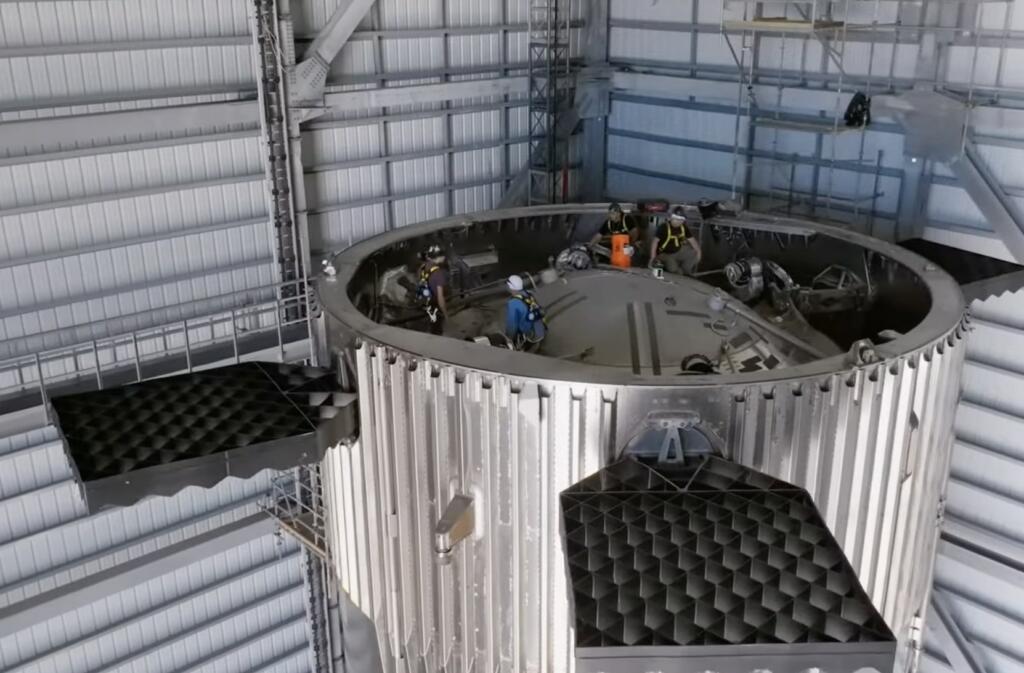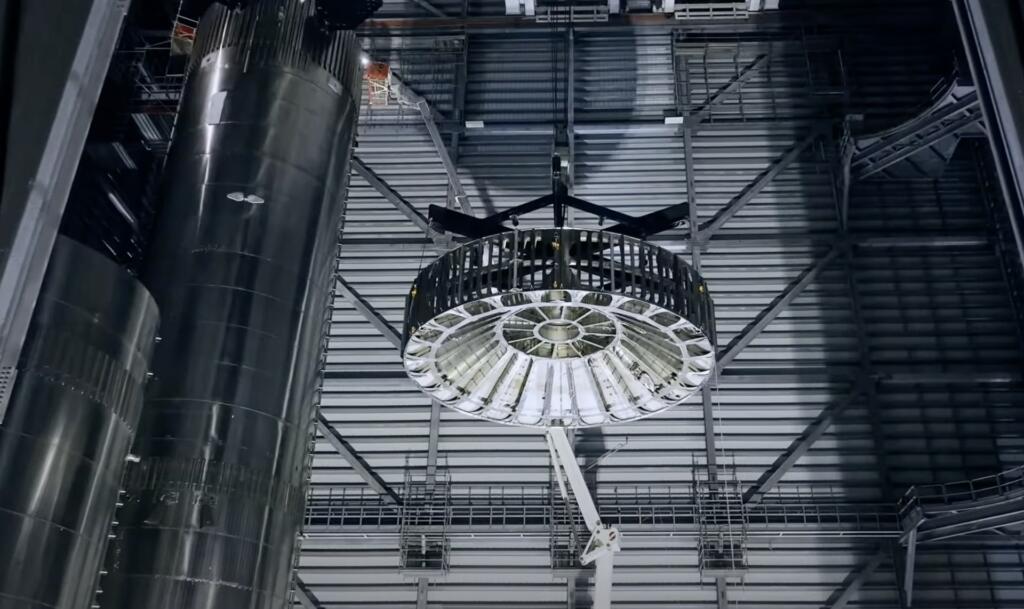The SpaceX Starship fleet is now over four Starship and three Super Heavy Boosters.
The construction of over one Raptor engine per day in 2024 will enable ten Starships and Super Heavy Boosters to be built in 2024.
The Raptor engine factory has the capacity to make over eleven Raptor Engines per day. This would be 4000 per year. This would be enough engines for one hundred Starships and Super Heavy Boosters.
At dawn from the gateway to Mars, the launch of Starship’s second flight test pic.twitter.com/ffKnsVKwG4
— SpaceX (@SpaceX) December 7, 2023





Brian Wang is a Futurist Thought Leader and a popular Science blogger with 1 million readers per month. His blog Nextbigfuture.com is ranked #1 Science News Blog. It covers many disruptive technology and trends including Space, Robotics, Artificial Intelligence, Medicine, Anti-aging Biotechnology, and Nanotechnology.
Known for identifying cutting edge technologies, he is currently a Co-Founder of a startup and fundraiser for high potential early-stage companies. He is the Head of Research for Allocations for deep technology investments and an Angel Investor at Space Angels.
A frequent speaker at corporations, he has been a TEDx speaker, a Singularity University speaker and guest at numerous interviews for radio and podcasts. He is open to public speaking and advising engagements.


The number of 33-engine Starships can be a lot fewer than the number of 9-engine Starships.
Early on, it is more likely that the Starship stage will be caught and reused than the upper stage successfully re-entering (heat tiles intact), flip, and caught. So I anticipate that SpaceX will grow its Starship fleet more than its booster fleet.
And, keep in mind that the Starship can be cheaper than the Falcon on a $/ton to orbit basis, even with the upper stage operating in a disposable mode. Once they have decent odds of reaching orbit, they can use the Starship to put payloads up there, (Such as Starlink satellites.) even during the testing phase.
“Mr. President, a fleet of starships just entered Earth orbit.”
“Do we know where they came from?”
“Some from Texas, the rest from Florida.”
I love it, but that’s a lot of capacity.
I still have a hard time imagining enough demand for that many starships. I’ve read the commentary about it being used for rapid transport of freight, but I’ve seen little evidence of infrastructure being built to support that.
The amount of Liquid Oxygen necessary for one launch is 80 metric tons. If 100 Starships flew 2X/day, that is 16,000 metric tons per day, or ~600,000 metric tons per year. The entire Global Market is only 10 million tons per year, and is already at capacity, with few new air separation plants being permitted, let alone built. It takes at least 3 years from proposing a new air separation plant to first production.
I know Elon Musk is smart, and SpaceX is chock full of great industrial supply chain experts, but until I see (1) a different fuel mixture for the Raptor engines, or (2) serious work being done to build more air separation plants, I just don’t see fuel supply for that many Starships for at least 7 years.
I hope I’m wrong.
As price falls, new products and markets emerge….
They’re not going to change the fuel mixture. There’s no practical alternative to LOX, and methane is very affordable. And changing the fuel would restart the development process even if there were practical alternatives.
So, the only way forward is building their own air separation plants.
“It takes at least 3 years from proposing a new air separation plant to first production.”
What’s the rate limiting step there? Permitting? Construction? Financing?
Financing shouldn’t be an issue, SpaceX will self-finance on that, not go to venture capitalists, they have plenty of cash flow.
Permitting is likely to be a serious issue if they have to do it in the US, given the level of lawfare and regulatory harassment they’re currently enduring. But, maybe they could build it in Mexico, right over the border? ITAR might prevent them from moving their rocket factory South, it doesn’t stop them from *importing* LOX North.
So, how long does the actual construction take? After all, they’re not going to be launching 2x a day 365 days a year starting in 2025…
Cryogenic air separation units (ASUs) use some of the largest compressors ever built to separate atmospheric air into its primary components, nitrogen and oxygen, as well as argon and other inert gases. A modern large ASU might consume up to 100 MW of electricity — that’s the capacity of a small power plant.
The 3-year window I give is due to the planning needed to (1) find a site, (2) finalize design and permitting, (3) manufacture the compressors, and (4) obtain an adequate, reliable electrical supply. If Musk & Co. could find a way to standardize the design of the Air Separation Unit and the compressors for his launchpads, this would speed things up considerably. However, 100 MW of power takes a while to add to the grid. I guess if modular nuclear reactors actually panned out, this would ease the electrical supply problem. Too bad they’re always “10 years away”.
The amount of land needed is small, less than 10 acres.
Keep an eye out for news from these 8 manufacturers of Air Separation Plants:
1. Hangyang
2. Linde
3. Air Liquide
4. KF
5. SASPG
6. Air Products
7. FORTUNE
8. TNSC
Only Linde, Air Liquide, and Air Products build units in North America and Europe. The rest are Chinese or Japanese suppliers.
None of them have been forecasting new units to supply SpaceX. (I worked for Air Liquide during their big Texas ramp-up in the 80s and 90s). Only Linde has the resources necessary to address SpaceX’s needs. They have expertise in modular and containerized systems for LOX production (albeit in tiny, 2.5 tons/day units).
But I’ve seen no evidence of collaboration between Linde and SpaceX. Any signs of that would make me reverse my opinion.
As an aside, Linde stock is up 156% over the last 5 years. And their free cash flow is Tesla-esque. I’ve been pleased with the small amount of shares I invested in them. Any news of a Linde/SpaceX agreement would cause me to buy more.
By the way, Brett: I’ve told you before, but I’ll say it again. I always enjoy reading your comments on here.
Thanks! Both for the complement, and the very informative post.
An alternate view. He could build and mass produce Stirling motors. Simplified design would require stamped sheet metal, a little welding and electromagnetic drive for the displacer and pistons. He has vast expertise available for all of these, from Tesla and SpaceX for the thermodynamics and welding. I’ll bet it would be vastly cheaper and no less efficient. Think of the work to build turbines, lots. I expect a Stirling design that was half-ass could be just as good or at least close and fast to design. I expect that a one month to six weeks of furious prototyping and then another month for tooling, and he could start mass-producing these things due to the expertise he has on hand. Instead of building one big machine, build a lot of little, small ones fast. Like his battery farms.
Re: Ramping up LOX production
It’s clear from previous reports that SpaceX is aware of the issue. Their engine production rate and statements about its expected increase appears to me to indicate that they are serious about achieving a 1,000 Starship fleet by 2030. Their Starship factory is another indication.
Do you all think that permitting time would be reversed further by companies expanding existing plants rather than building brand new ones?
I imagine that there is a well coordinated ramp-up strategy where flights become increasingly common and where LOX companies are worked with to expand their production while SpaceX works to develop their own sources as their need increases.
The answers to your questions are ‘yes’ and ‘no’.
1. Some Air Separation Plants are on sites big enough to expand. Many are not.
2. Many existing plants are purpose-built for a particular manufacturing site: Ultra High purity nitrogen plants are located inside semiconductor manufacturing plants (Intel, Texas Instruments, etc.) for blanketing purposes (keeping contaminants (dust and oxygen, CO2, trace gases, etc.) out of the production area). LOX plants are also built inside of paper and cardboard manufacturing sites for bleaching purposes. There is a variety of industries who need large amounts of LN and LOX. Petroleum Refineries, metal smelters, etc.
3. I am assuming any Starships used for freight shipments will have rocket pads near manufacturing/industrial/distribution/military areas, but far away from residential and commercial. Maybe SpaceX could adopt the FedEx/UPS/Amazon model and have a spoke and hub system. I don’t know, just spitballing. I do know Starship rockets are LOUD. I can’t imagine any residential centers putting up with the noise generated by multiple launches per week. SpaceX’s 3 launch sites (Florida, California, and Texas) are remote for a reason.
4. One thought has always intrigued me: What if Elon bought sparsely populated, but large chunks of land within 20-40 miles of large manufacturing/distribution/military areas, and then built his launch pads with huge warehouses surrounding them? Launch towers with Mechzilla arms, LOX tanks and methane tanks near the pads to load the Starships with cryogenic fuel.
Air separation units and methane chillers maybe a mile away. Tesla semi’s with cryogenic tank trailers to transport the LOX and methane to the launchpad tanks. The huge SpaceX warehouses built nearby could hold the freight to be loaded on the Starships, and the warehouses could use Teslabots for labor. It would give SpaceX/Tesla another gigantic ecosystem advantage in a newly created (but massively profitable) field.
5. If all of this were to play out by 2030, Elon & Co. need to get started ASAP. The amount of planning, purchasing of land and equipment, engineering, permitting, etc is massive. Maybe 4 big launch areas to start (Los Angeles, NY/NJ, Chicago, and D/FW), then later on Detroit, Central Ohio, Houston. Once the concept proves out, US manufacturing centers, European manufacturing centers, and Asian manufacturing centers would be tripping over themselves to bring in this system. (If Brazil ever stabilizes, maybe they would want in on it. They have enormous manufacturing facilities and resources, but the profitable markets they covet are quite far away.)
6. As an aside, If the U.S., Europe, S. Korea, Japan, and other friendly nations cooperated on this but excluded China and Russia, can you imagine the leverage that could be exerted? (I like the Russian and Chinese peoples, but their governments are evil).
I wish I could prod Elon to make this a priority.
P.S. (Elon, if you want to bring me in to help, I wouldn’t mind. I have a long record of growing and expanding manufacturing companies.)
That comes to no more than 213 engines. They should now be at about 400 engines of different development levels. So, they could afford to make quite a few more upper stage Starships.